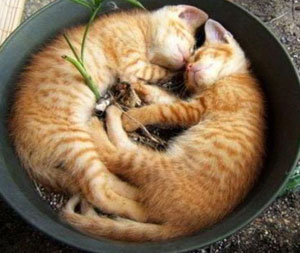
Author:Vicki Santillano

Like humans, all animals fall into sleep stages, each with varying lengths and levels of consciousness. And there’s no question that some of them actually have dreams—my slumbering dog’s growls and leg twitches are reliable sources of entertainment. What’s less clear is which animals have the capacity to dream, and if they do, whether or not their dreams look like ours. When my sleeping dog starts breathing rapidly and making running motions, I imagine he’s envisioning a field of bunnies, but I wonder how accurate that is. We often give our pets human attributes, but how close do they come to mimicking our way of dreaming—if they dream at all?
The Eternal Hunt of Cats and Dogs
All animals have resting periods, but not all experience REM sleep, the deep-sleep stage that hosts dreams. However, almost all land mammals—including cats, dogs, hamsters, and horses—reach this stage in their cycles. Of course, there’s no way of knowing what they dream about specifically. (I’ve tried asking my dog and he remains steadfastly silent.) Since humans draw on past experiences for their dream content, it stands to reason that cats and dogs do the same thing, which would explain why most of their sleep movements indicate hunting and chasing. Whether their sleep sagas incorporate imagination into the mix is up for debate, but the fact that the dream indicators for cats and dogs are so repetitive and common—barks, paw movements, eye fluttering—suggests their dreams are pretty monotonous.
Birds Hear the Music
Birds also experience REM sleep, but for a long time, people assumed bird brains didn’t function enough to produce dreams. Then a 2000 study done at the University of Chicago and published in Science found that songbirds actually sing in their sleep—not vocally, but by imagining the songs while they snooze. The signals transmitted throughout their brains while they are awake and singing are also transmitted during sleep. Scientists involved in the study believe it’s a way for birds to learn a variety of voice pitches and tunes—kind of like rehearsing different speeches. Perhaps this is also how parrots learn to imitate certain sounds. Research has also shown that, unlike humans, birds don’t visualize anything during REM sleep. They might hear music when they sleep, but they lack images to accompany the noise.

A Boring Sleep for Our Reptile Friends
Studies on the sleeping patterns of reptiles seem to indicate that they don’t experience REM sleep, which differentiates them from mammals and birds. Like all other animals, they do sleep (even snakes, though it looks like they’re constantly awake because they lack eyelids), but it’s believed that their brains are too primitive to have the ability to dream. So when we observe snakes, lizards, turtles, and any other reptiles we keep as pets, we can remain fairly certain we know exactly what they’re dreaming about—absolutely nothing.
There’s something nice about the fact that our dogs and cats dream and that they’re able to channel and exercise the natural-born instincts (like hunting) that are often quelled by their roles as domestic pets. And even if birds can’t have visual dreams while sleeping, at least they might enjoy some good music or sounds in the process. As for reptiles, well, at least their brains aren’t developed enough to even know what they’re missing.
Our pets may be on to something with their dream habits (or lack thereof). Chasing things and learning new songs sounds like a pleasurable alternative to the complex, confusing scenes prevalent in many of our dreams. Instead of wondering whether pets dream like us, maybe we should start dreaming more like them. Even a dreamless night beats a nocturnal encounter with the Boogeyman. Hmm … maybe those reptiles are smarter than we think.